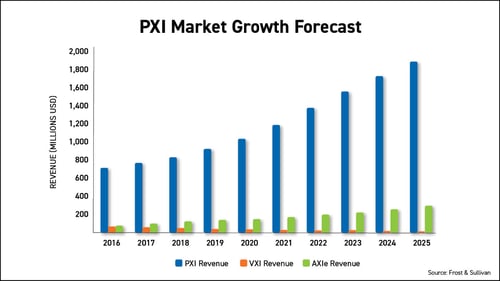What is PXI? Your Questions Answered.
What is PXI - Background and History
PXI, which stands for PCI eXtensions for Instrumentation, is a durable PC-based platform designed for measurement and automation system solutions. It offers the advantages of low cost, high performance, and the flexibility of cutting-edge PC technology, along with the benefits of an open industry standard. PXI integrates standard PC technology with the mechanical form factor of the CompactPCI™ specification and incorporates integrated timing and triggering, resulting in a robust platform that significantly enhances performance compared to other test and measurement architectures.
The mechanical, electrical, and software characteristics of PXI establish comprehensive systems for testing, measurement, data acquisition, and manufacturing applications. PXI has emerged as a leading industry standard for measurement and automation in sectors such as military and aerospace, automotive, manufacturing testing, machine monitoring, and industrial testing.
The PXI Standard

PXI is governed by the PXI Systems Alliance (PXISA), a group of more than 50 companies chartered to promote the standard, ensure interoperability, and maintain the PXI specification. Because PXI is an open specification, any vendor who joins the Consortium can build PXI products. CompactPCI, the standard regulated by the PCI Industrial Computer Manufacturers Group (PICMG), and PXI modules can reside in the same PXI system without any conflict because of interoperability between CompactPCI and PXI is a key feature of the PXI specification.
The PXI standard defines the mechanical, electrical, and software interfaces provided by PXI-compliant products, ensuring that integration costs and software costs are minimized and that trouble-free multi-vendor solutions are implemented.
A PXI system appears as an extension to the peripheral slots in the user’s controller, regardless of whether the controller is embedded in the PXI chassis or is a separate computer.
The PXI modules, which provide the instrument and switching functions, are plugged into a chassis. This chassis may include its own controller running industry-standard operating systems or a PC peripheral slot to the PXI bridge that provides a high-speed link to a desktop PC.
Depending on the connector types fitted to a module, CompactPCI and PXI products are interchangeable; they can be used in either CompactPCI or PXI chassis; however, installation in the alternate chassis type limits the functionality of certain features.
What is PXI - The System consists of three main components:
- PXI chassis - serving as the system's backbone, the chassis features a high-performance backplane that enables rapid communication between the cards in the system. It also supplies power and cooling, with chassis options ranging from two to twenty slots. Typically, these chassis are designed to accommodate either 3U or 6U PXI modules, and the PXI standard supports designs that can house both sizes. While the PXI specification mandates certain essential components, it does not impose strict standards on what can be included in a PXI chassis. Consequently, PXI chassis differ in their capabilities, requiring users to select the chassis that best suits their specific needs.
- The System Controller - the PXI chassis can accommodate either an embedded controller in the Slot 1 position or an interface module for connecting to an external controller, such as a PC. Utilizing a standard PC offers a highly cost-effective yet powerful solution. The choice of PXI controller depends on the specific application. PXI is versatile enough to be configured for internal embedded controllers, laptops, and desktop PCs.

- The Modules - these come in many different varieties, including test instruments that take a wide variety of measurements such as voltage, current, frequency, and signal and waveform generators. They can also perform other functions, including boundary-scan test, image acquisition, power supplies, switching, etc.
PXI Software
The PXI standard is reliant on a standardized software and hardware environment. Since PXI is based on the PCI standard, many PCI/PCIe routines can be moved into the PXI environment. The PXI modules cannot be controlled from a physical front panel. Therefore software control via the backplane is required. Minimum requirements are for Windows 32-bit drivers, and there is also an extension for supporting Linux.
IVI drivers are optional. They are sophisticated instrument drivers that feature increased performance and flexibility for more complex test applications that require interchangeability, state-caching, or instrument simulation. To learn more about IVI drivers, please visit the IVI Foundation's website: http://www.ivifoundation.org.
PXI Market Acceptance
According to the PXISA, over 100,000 PXI systems have been deployed, incorporating more than 600,000 instruments. Currently, over 60 member companies of PXISA have developed more than 2,500 distinct PXI modules. (Source: PXISA website) As indicated in Figure 1, the 2021 Frost and Sullivan Modular Instrumentation study forecasts that the PXI instrumentation market will grow at a compound annual growth rate of 18.1% over the next five years. At this pace, the PXI market is projected to surpass 1.8 billion USD by 2025.

What is PXI Express (PXIe)?
As the commercial PC industry drastically improves the available bus bandwidth by upgrading from PCI to PCI Express, PXI can meet even more application needs by integrating PCI Express into the PXI standard. To ensure the successful integration of PCI Express technology into PXI and CompactPCI backplanes, engineers within the PXISA and the PICMG worked to ensure that PCI Express technology can be integrated into the backplane while still preserving some compatibility with the large installed base of existing modules. With PXI Express, users will benefit from significantly increased bandwidth, guaranteed backward compatibility, and additional timing and synchronization features.
Take a look at our Knowledgebase article - "Comparing PXI and PXI Express"
Want more PXI Information? Check out our PXImate eBook.
This book provides an overview of the PXI standard and helpful information about the technology behind the switching and instrumentation modules a typical chassis can contain. It is a guide for those new to PXI systems and a valuable source of reference material for the more experienced.

